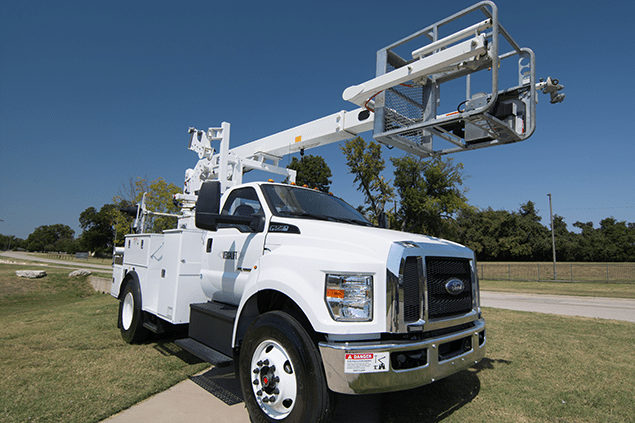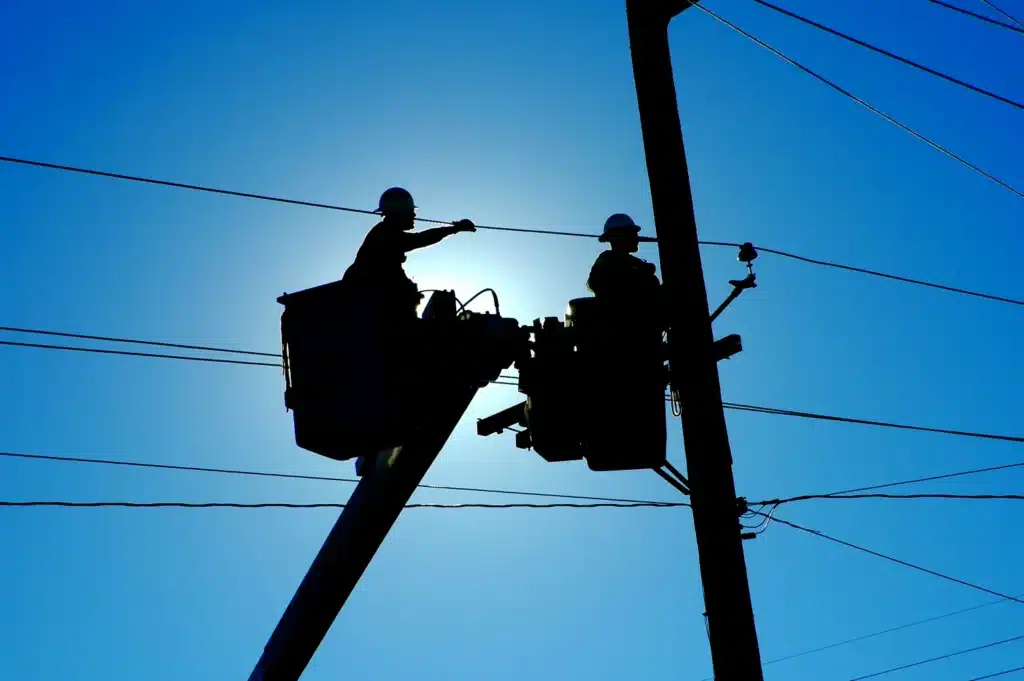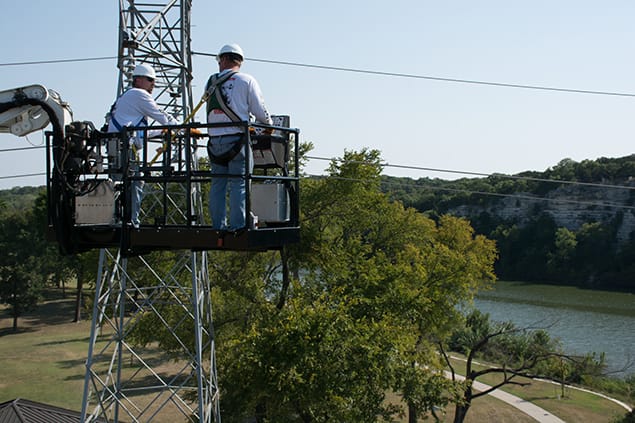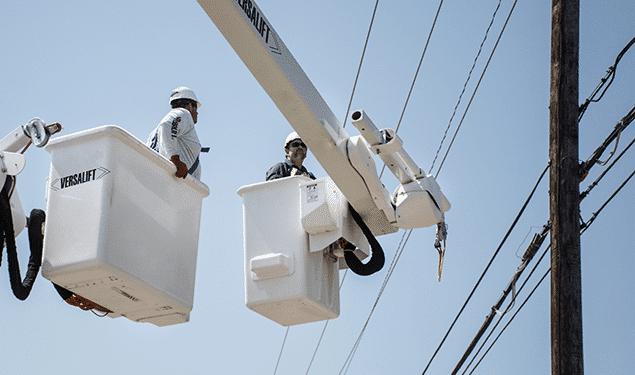A utility truck is a specialized vehicle designed to support work crews in various field operations, particularly tasks involving elevated work or material handling.
Utility trucks are essential equipment across many industries, including electric utilities, telecommunications, construction, municipal services, and more, providing safe access, storage, and tool capabilities tailored to job-specific requirements.
Definition and General Purpose
Utility trucks, sometimes referred to as utility vehicles or service trucks, typically include a sturdy chassis, specialized storage compartments, hydraulic systems, and elevating booms or lifts. Their primary purpose is to facilitate efficient access to elevated or difficult-to-reach work areas, transport necessary tools and equipment, and ensure worker safety.
Explore our specialized Utility Truck Solutions for Electric Utilities and discover how Versalift can elevate your operations.
Common Types of Utility Trucks
Utility trucks come in a variety of forms, each designed to meet the specific demands of different field applications. Understanding the different types of utility trucks – and how they are used – can help businesses choose the right equipment to improve jobsite efficiency and safety.
- Bucket Trucks: These trucks feature aerial lifts and platforms that allow workers to perform tasks at height safely and efficiently. Common in electric utility and tree care work, bucket trucks eliminate the need for ladders or scaffolding and provide a secure, elevated workspace.
- Digger Derricks: Purpose-built for pole installation and heavy lifting, digger derricks combine auger systems, hydraulic booms, and lifting winches. They’re widely used in the power and telecommunications industries for digging holes, placing poles, and setting transformers.
- Service Trucks: These are versatile vehicles equipped with enclosed compartments and mounted tool systems for maintenance, repair, and field service operations. Service trucks are essential for crews that need mobility and ready access to a full suite of tools.
- Cable Placer Trucks: Used mainly by telecom providers, these trucks allow crews to place, retrieve, and maintain overhead cabling safely. Their telescoping booms and cable-handling gear help streamline fiber and cable installation across urban and rural routes.
- Material Handler Bucket Trucks: These trucks combine aerial lift capabilities with the ability to handle and lift heavy materials using integrated jibs or winches. They are ideal for teams that need to position equipment or components at height without requiring separate lifting systems.
- Aerial Lifts: A broader category often overlapping with bucket trucks, aerial lifts are designed to elevate personnel and tools to overhead work areas. These may include telescopic boom lifts, articulating boom lifts, and vertical mast lifts. Utility trucks with integrated aerial lifts are commonly used in both electric utility and sign & lighting applications, offering flexible reach and maneuverability in compact or congested environments. Choosing the right aerial lift involves evaluating factors like working height, outreach, platform capacity, and terrain adaptability.

Key Industries That Use Utility Trucks
Utility trucks are foundational across a wide range of sectors. Each industry has distinct operational challenges, but all benefit from the safety, efficiency, and reliability these vehicles provide. Knowing how utility trucks are deployed in different fields helps highlight their broad utility and the importance of purpose-built configurations.
- Electric Utilities: Utility trucks are essential for maintaining and repairing power lines, transformers, and substations. With insulated booms and extended reach, these trucks keep linemen safe while working on live lines or in tight spaces.
- Telecommunications: Telecom technicians rely on utility trucks to install and maintain cabling infrastructure, antennas, and network hardware – often in elevated or hard-to-reach areas.
- Municipal Services: City and county departments use utility trucks for everything from maintaining streetlights and traffic signals to tree trimming and seasonal decorations. Versatility and ease of use are key.
- Construction & Infrastructure: Utility trucks assist with signage installation, overhead structure inspection, and lighting work on construction sites where reach and tool access are critical.
- Forestry & Tree Care: Arborists use utility trucks with elevated platforms to safely trim, remove, or inspect trees – especially those near power lines or roadways.
- Sign, Light & Traffic: Maintenance of traffic control devices, digital signage, and public lighting systems requires specialized utility trucks capable of precise, high-access work.

Common Utility Truck Features
While utility trucks are configured for different tasks, many share a core set of features that make them essential to modern fieldwork. These components are not only practical – they’re also critical to worker safety and operational efficiency. Understanding what features are available can guide procurement decisions and help optimize jobsite performance.
- Telescopic or Articulating Booms: Provide versatile reach for varying job requirements.
- Material Handling Systems: Winches, jibs, or cranes integrated for heavy lifting and placement tasks.
- Outriggers and Stabilizers: Ensure vehicle stability and safe operation on uneven terrain.
- Tool Circuits and Storage: Dedicated compartments and circuits for hydraulic or pneumatic tools.
- Insulated Platforms: Crucial for electrical safety, protecting operators from electrical hazards.
Read our article about the specialized setups in utility trucks.
Benefits of Using Utility Trucks
The use of utility trucks brings measurable advantages to field operations of all sizes. These vehicles are more than just transport or lift systems; they’re purpose-built workstations that increase speed, consistency, and safety. By choosing the right truck configuration, companies can address a variety of on-site challenges more effectively.
- Enhanced Safety: Safe, secure platforms minimize fall hazards and improve worker protection.
- Increased Productivity: Reduce downtime and eliminate the need for additional lifting equipment or scaffolding.
- Versatility: Suitable for multiple tasks across various worksites and industry applications.
- Cost Efficiency: Lower total cost of ownership due to high durability, reliability, and reduced equipment redundancy.
Proper maintenance plays a crucial role in extending the service life and cost efficiency of utility trucks. By following regular inspection schedules and preventive care guidelines, fleet managers can ensure long-term performance, reduce costly repairs, and improve overall safety. Learn more in our detailed guide on how to maintain a utility truck for long-term safety and performance.

Regulations and Safety Considerations
Utility trucks must be operated within a regulatory framework designed to protect workers and the public. Ensuring compliance not only reduces liability but also extends the life and effectiveness of the equipment. Understanding these regulations helps teams maintain a proactive approach to safety and maintenance.
- OSHA Standards: Guidelines for aerial lifts and fall protection.
- ANSI Requirements: Specifications for vehicle construction and safe use.
- DOT Compliance: Regulations for road safety and vehicle operation.
- Routine Maintenance: Regular safety inspections and preventive maintenance to ensure operational readiness and compliance.
Learn more about safety operating utility trucks here.

Choosing the Right Utility Truck
Not all utility trucks are created equal. Selecting the right model depends on numerous factors including work height, terrain, material handling requirements, and crew size.
Evaluating these elements ensures your team gets the equipment they need to perform at their best. Partnering with an experienced manufacturer like Versalift ensures long-term value and operational fit.
Learn more about what innovations and features to look for in utility trucks.
Utility Trucks Built to Power Your Industry
Utility trucks are vital assets, supporting diverse tasks from utility line maintenance to urban infrastructure upkeep. Versalift provides industry-leading utility trucks designed for reliability, safety, and productivity across sectors.
Contact our expert team today to configure the perfect utility truck solution tailored to your specific needs.

